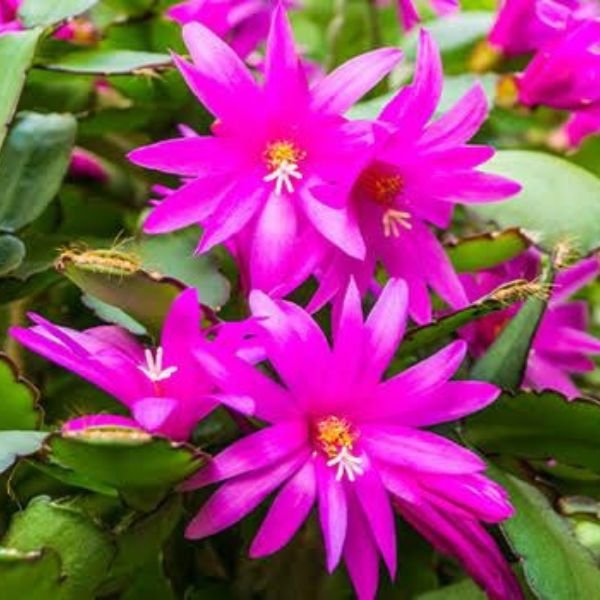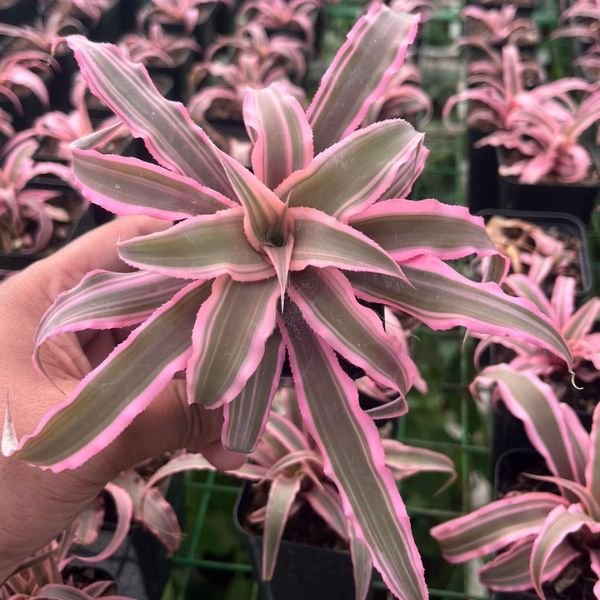The snake plant is known as Sansevieria or Mother-in-Law\’s Tongue. This remarkable snake is an exceptional indoor plant that becomes happy with minimal care. This evergreen perennial plant features elongated, sword-shaped leaves. These leaves of the snake plant stand upright that look like the sharp tongue of a serpent, hence the name \”snake plant.\” Another beauty of their leaves is the exhibit of stunning variegation with shades of deep green with lighter streaks or patterns.
It originated from parts of Africa and other tropical areas and belongs to the Asparagus Family. The leaves of the snake grow in rosettes. You can place your snake plant alone or as part of an indoor plant collection. The leaves coloration varies across different cultivars, from classic deep green with cream-yellow edges to silver-green with dark green patterns.
Snake plants have robust roots and rhizomes, this adaptation helps the plant survive in arid conditions. The roots and rhizomes also allow for the easy propagation of new snake plants, allowing you to expand your green haven without additional costs.
Though not a common occurrence in indoor settings, the snake plant can produce either cylindrical creamy flowers or nocturnal fragrant flowers under specific conditions. Not every snake plant bloom, hence the blooming of the snake plants depend on the variety.
Unlike some cacti that require specialized care, the snake plant thrives on neglect. Its ability to tolerate low light conditions and long periods without watering is perfect for busy and new gardeners. It is a cost-effective option that brings beauty to your living space without requiring constant attention or expensive maintenance.
Temperature
Snake plants are hardy and adaptable, but maintaining the right temperature is crucial for their well-being. Ideally, keep your snake plant in a temperature range between 18°C to 29°C during the day. It is suggested to avoid exposing it to temperatures below 10°C.
These plants can withstand slightly cooler temperatures at night. Put your snake plants from indoor to outdoor environments to avoid sudden temperature fluctuations.
Watering
One of the most common mistakes in snake plant care is overwatering. To prevent root rot and maintain healthy growth, only water after allowing the top inches of the soil to become completely dry. Typically, you can water your snake plant every 2-4 weeks.
You need to maintain watering frequency based on factors like humidity, light exposure, and other factors. During the dormant winter months, reduce watering to avoid excess moisture.
It is better to underwater than overwater, as snake plants are more suitable to drought conditions than waterlogged. Yet, prolonged under-watering can harm the leaves of snake plants.
Fertilizer
Snake plants do not need much fertilizer requirements. During the growing season, which typically spans from summer to spring, apply a balanced, water-soluble fertilizer with an N-P-K ratio of 10-10-10 or 20-20-20, diluted to half strength. You can also try the slow-release fertilizer.
Feed your snake plant once a month to provide the necessary nutrients for steady growth, only during the growing season. Shut down the fertilization process in dormant winter months, as the plant\’s growth slows down significantly during this time. Overfertilization can lead to nutrient imbalances as a result, it causes damage to the roots of snake plants.
Light
Snake plants are adaptable to various light conditions. These plants thrive in moderate to bright indirect light. Ideally, place your snake plant near a north or east-facing window to provide sufficient sunlight. Exposing snake plants to harsh, direct rays is not good for them.
However, they can tolerate low light conditions, though low light slows down their growth or trouble the photosynthesis process. On the other hand, too much direct sunlight can scorch their leaves, which is the uniqueness of these plants. By striking the right balance between light and shade, you can enjoy a vibrant and healthy snake plant that graces your living space with its beauty.
Types of snake plants
Sansevieria ‘Black Dragon’ (Indoor Plant):
Sansevieria ‘Black Dragon,’ a stunning indoor plant that has dark and glossy dark green leaves, and its upright and sword-like shape creates a sophisticated compact look.
The \’Black Dragon\’ requires minimal care to perform its air-purifying qualities to ensure a healthier environment. The blackish tone over the green leaves is an extraordinary feature of this snake plant variety.
Sansevieria Bird’s Nest Snake Plant (Indoor Plant):
Sansevieria Bird’s Nest Snake Plant is a draft indoor variety cherished for its charming rosette-shaped arrangement of leaves. This plant showcases glossy, dark green-white leaves that beautifully resemble a bird\’s nest. Its compact and unique leaves come from its underground stem.
As an air-purifying plant, the Bird\’s Nest Snake Plant contributes to cleaner indoor air. With its low maintenance requirements and adaptability to various light conditions. the leaves of this mother-in-law tongue plant are upwardly leaned in a spiral manner of its stem and that effortlessly brightens up any corner of your home.
Sansevieria Dracaena Masoniana Snake Plant (Indoor Plant):
Sansevieria Dracaena Masoniana Snake Plant or Whale Fin or Shark Fin plant, belonging to the Sansevieria genus. Its eye-catching leaves resemble the crinkled green paddles.
This Congo native available in various sizes and bold appearances and becomes an instant attraction with its fragrant greenish-white blooms. Like snake plant varieties, the Dracaena Masoniana is low-maintenance and air-purifying. Place it in moderate to bright indirect light to thrive with minimal care.
Sansevieria Golden Hahnii Snake Plant (Indoor Plant):
Sansevieria Golden Hahnii Snake Plant is a captivating indoor variety, belonging to the Sansevieria genus. This compact gem has prepared vibrant yellow-banded greyish-green leaves from its creeping rhizome.
The color of the Golden Hahnii\’s long and sharp leaves differs from light, dark, and greyish- green, even some varieties produce charming flower spikes. Its dwarf size and attractive appearance make it perfect for smaller spaces, such as desks, shelves, or window sills.
As a low-maintenance plant, the Golden Hahnii thrives in various light conditions, making it an ideal choice for any home. With its air-purifying properties, it not only beautifies your space but also promotes a healthier living environment.
Sansevieria Hahnii ‘Silver Streaker’ (Indoor Plant):
Sansevieria Hahnii \’Silver Streaker\’ , a mesmerizing indoor variety that captivates with its unique silver-green variegation. As part of the Sansevieria genus, this charming plant displays striking white and ashed leaves that form a rosette. Its leaves are sharp-pointed
Its compact and versatile nature allows it to thrive in a wide range of light conditions, from low light to bright indirect light. Like other snake plants, the \’Silver Streaker\’ is an air-purifying gem, actively improving the air quality in your space.
Sansevieria Trifasciata ‘Jade Dwarf Marginated’ (Indoor Plant):
Sansevieria Trifasciata \’Jade Dwarf Marginated is a compact indoor variety. This charming plant features striking jade green leaves bordered by delicate yellow-colored margins.
Its leaves have the compact size and graceful appearance of a rosette. Another attractive part of it is its scented greenish-white blooms. Thriving in a wide range of light conditions, from low light to bright indirect light, the \’Jade Dwarf Marginated\’ is an excellent choice for beginners and experienced gardeners.
Potting and Repotting Guide
Potting and repotting your snake plant is a simple process. Start with a well-draining pot to prevent waterlogging, as the plant dislikes soggy soil. A mixture of cactus or succulent soil with more sand than perlite works wonders.
When repotting, choose a container that allows a couple of inches of extra space for root growth. Repot every 2-3 years in the spring, using fresh potting mix. Gently remove the plant from its current pot, being cautious not to damage the roots. Trim away any damaged or rotting roots before placing them in the new container.
During the repotting process, keep the snake plant upright and centered while adding fresh soil around the roots. Pat the soil gently to ensure stability. Water sparingly immediately after repotting to prevent overwatering
Your snake plant will flourish by fulfilling its requirement and reward you with its air-purifying quality.
Pest and diseases
Common pests:
Though relatively pest-resistant, snake plants can still fall victim to common pests such as spider mites, thrips, mealybugs, and scales. Regularly inspect your plant for signs of pests. Whenever you notice a pest problem, act promptly and use natural remedies like neem oil or insecticidal soap to eliminate the pests and prevent further damage.
Rot root:
Snake plants suffer from overwatering and it makes their roots rot which happens due to overwatering or poor drainage. To prevent root rot, ensure your pot has adequate drainage holes and use a well-draining soil mix. Do not make your plant sit in standing water. If you notice wilting or yellowing leaves, adjust your watering habits immediately.
Fungal Infections:
Fungal infections can occur if the plant is exposed to excess moisture or high humidity. Improve air circulation around the plant, especially in humid environments, to reduce the risk of fungal growth. Also, avoid water splashing on the leaves during watering, as this can create favorable conditions for fungal pathogens.
Propagation
Two effective methods for propagating snake plants are leaf cuttings and seeds.
Leaf-cutting
To start with leaf cuttings, select a healthy leaf from your mature snake plant. With a clean, sharp knife, make a clean cut near the base of the leaf. Allow the cutting to dry and form a callus.
Plant the calloused end into a well-draining potting mix, burying it about an inch deep. Water sparingly and keep the cutting in a warm, well-lit spot. Within a few weeks, you should notice new shoots sprouting from the cutting.
Seeds:
Propagation through seeds requires a bit more patience. Collect dry seeds from the flowers of your mature snake plant. Sow the seeds in a light, well-aerated potting mix, and cover them lightly with soil. Maintain a consistently moist environment and place the pot in a warm location with indirect light. Germination may take a few weeks to a couple of months, but soon enough, tiny snake plant seedlings will emerge.
Problems related to leaves of snake plant
The uniqueness of the snake plant is its leaves. This discussion from yellowing leaves to leaf spots ensures your snake plant foliage remains in perfect condition. Snake plants deserve the best care to showcase their striking leaves.
Yellowing or drooping leaves
Yellowing or drooping leaves are often a sign of overwatering or underwatering. To remedy this issue, adjust your watering routine. Allow the soil to dry slightly between waterings, and avoid letting the plant sit in standing water. Remember, snake plants prefer to be slightly on the drier side, making them perfect for busy plant owners.
Curling or wrinkled leaves
Curling or wrinkled leaves can be a response to under-watering. Ensure your snake plant should be watered enough to get its upright shape. High- temperatures can also cause the wrinkled leaves of your snake plant
Brown leaf Spots
Leaf spots can be caused by various factors, including fungal infections, temperature fluctuations, or over-fertilizer. Avoid wetting the leaves while watering, as this creates a favorable environment for fungi. Ensure good air circulation and remove affected leaves promptly to prevent further spread.
The thing to know about it
It has air-purifying properties, although generally safe, yet it\’s essential to keep it out of reach of curious pets and children, as ingesting its leaves may cause mild gastrointestinal issues. Embrace the beauty of this low-toxicity gem while taking precautionary measures to keep it safe for all.
Additional care tips
Proper pruning is a fundamental aspect of snake plant care. Regularly inspect your plant for any signs of yellowing or damaged leaves and gently trim them at the base using clean and sharp pruning shears. Pruning promotes new growth and keeps your plant looking its best. Additionally, removing dust from the leaves helps enhance their ability to purify the air efficiently.






